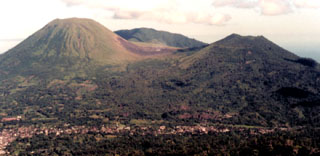Report on Lokon-Empung (Indonesia) — 14 June-20 June 2023
Smithsonian Institution / US Geological Survey
Weekly Volcanic Activity Report, 14 June-20 June 2023
Managing Editor: Sally Sennert.
Please cite this report as:
Global Volcanism Program, 2023. Report on Lokon-Empung (Indonesia) (Sennert, S, ed.). Weekly Volcanic Activity Report, 14 June-20 June 2023. Smithsonian Institution and US Geological Survey.
Lokon-Empung
Indonesia
1.358°N, 124.792°E; summit elev. 1580 m
All times are local (unless otherwise noted)
In a press release PVMBG reported increased emissions at Lokon-Empung on 13 June with dense white plumes rising 400 m above the rim of Tompaluan Crater and drifting S; a total of 12 earthquakes indicating emissions were recorded by the seismic network. The emissions were followed by a period of continuous tremor during 1835-2100. White steam-and-gas emissions of variable densities rose as high as 500 m and drifted N, W, and S during 14-20 June. During 2023 white emissions generally rose 20-150 m above the crater rim and seismicity was generally dominated by 1-2 daily shallow volcanic earthquakes. The volcano Alert Level remained at 2 (on a scale of 1-4) and the public was reminded not to approach the crater within a radius of 1.5 km.
Geological Summary. The Lokong-Empung volcanic complex, rising above the plain of Tondano in North Sulawesi, includes four peaks and an active crater. Lokon, the highest peak, has a flat craterless top. The morphologically younger Empung cone 2 km NE has a 400-m-wide, 150-m-deep crater that erupted last in the 18th century. A ridge extending 3 km WNW from Lokon includes the Tatawiran and Tetempangan peaks. All eruptions since 1829 have originated from Tompaluan, a 150 x 250 m crater in the saddle between Lokon and Empung. These eruptions have primarily produced small-to-moderate ash plumes that sometimes damaged croplands and houses, but lava-dome growth and pyroclastic flows have also occurred.
Source: Pusat Vulkanologi dan Mitigasi Bencana Geologi (PVMBG, also known as CVGHM)

